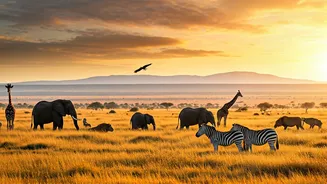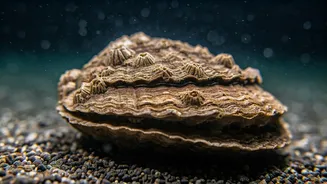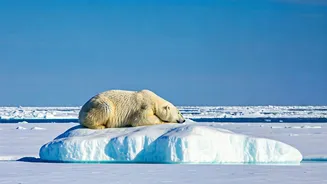Ocean Quahog's Endurance
The ocean quahog (Arctica islandica) claims the top spot, known for its exceptional longevity. These marine bivalves can live for over 500 years, making
them among the longest-lived animals on the planet. Their impressive lifespans are attributed to slow metabolic rates and the ability to withstand extreme environmental conditions, particularly in the cold waters where they reside. The shell of an ocean quahog acts as a record book, with growth rings offering clues about its age and the environment it has experienced over centuries. The oldest recorded ocean quahog was estimated to be over 500 years old, offering scientists valuable insights into the effects of climate change and environmental stressors over extended periods. Their remarkable ability to endure highlights the adaptability of life and the hidden wonders of the ocean depths.
Greenland Shark's Secret
The Greenland shark stands out as another remarkable long-lived species. These slow-moving sharks inhabit the cold waters of the Arctic and North Atlantic Oceans and are known for their incredibly slow growth rates. Studies have estimated that some Greenland sharks can live for over 400 years, a lifespan that surpasses many other vertebrates. Scientists have used radiocarbon dating of the shark's eye lenses to determine their ages, providing precise data on their longevity. The extended lifespan of the Greenland shark is linked to its slow metabolism and the cold temperatures of its environment. Their long lives have made them the oldest known vertebrate animals on Earth. The Greenland shark's story offers a compelling glimpse into the adaptability and enduring nature of marine life in extreme environments, making it a key subject of ongoing research.
Bowhead Whale's Longevity
The bowhead whale, another inhabitant of the Arctic and subarctic waters, is celebrated for its remarkable lifespan, frequently reaching over 200 years. These massive marine mammals are known for their robust health and slow aging process. Bowhead whales, also known as the Greenland Right Whale, often accumulate considerable baleen, which is a filtering system within their mouths. Analyses of harpoon fragments found embedded in bowhead whales from historic whaling practices have helped researchers determine their ages and understand their remarkable longevity. The extreme cold of their natural habitat, together with a possible reduced rate of cellular damage, may be a primary reason for their long lifespans. The bowhead whale's existence represents resilience in an unforgiving climate, illustrating the enduring nature of marine life.
Galapagos Tortoise's Legacy
The Galápagos tortoise, a giant among land animals, is famed for its longevity, frequently living over 100 years and sometimes exceeding 150 years. These tortoises, endemic to the Galápagos Islands, have adapted to thrive in their unique island environment. Different subspecies of Galápagos tortoises exhibit varied shell shapes and sizes based on their specific island habitats. Factors contributing to their long lives include their slow metabolism, robust shells offering protection from predators, and a diet rich in vegetation, aiding in their ability to survive for multiple decades. Historical data has shown that these tortoises have played a significant role in island ecosystems for centuries, their longevity a testament to their evolutionary success. Their remarkable ability to endure makes the Galápagos tortoise an iconic symbol of resilience in the natural world.
Rougheye Rockfish's Persistence
The rougheye rockfish is known for its exceptional lifespan among fish species, with individuals living for over 200 years. This deep-sea fish, found in the North Pacific Ocean, has adapted to survive in challenging conditions. The rougheye rockfish's extended lifespan is associated with its slow metabolism and its habitat in the cooler waters. Scientific studies, analyzing growth rings in their ear bones (otoliths), have provided insights into their age. These fish are known to grow at a slow rate, and that enables them to live for multiple decades. This longevity offers the opportunity to understand environmental changes and the impacts on marine ecosystems. They also play a significant role in their environment, contributing to the balance of the ocean food chain.
Red Sea Urchin’s Endurance
The red sea urchin, a spiny invertebrate found in the Pacific Ocean, is another animal with a remarkable lifespan. These sea urchins can live for over 100 years, and some may even live for over 200 years. Their longevity has fascinated researchers, leading to studies on their aging processes and cellular maintenance. The longevity is, in part, due to the fact that they have slow metabolisms and are well adapted to the deep waters. They appear to have minimal cellular aging, with the ability to continually renew their tissues. The red sea urchin's unique biology provides valuable insights into the possibilities of slowing down the aging process in other organisms. The longevity of red sea urchins contributes to the stability of their ecosystems.
Immortal Jellyfish’s Rebirth
The immortal jellyfish (Turritopsis dohrnii) has gained a reputation as one of the most remarkable animals because of its ability to potentially live forever. Unlike other jellyfish, this small, transparent species can revert to a polyp stage when faced with stress or injury, effectively reversing its aging process. The immortal jellyfish are distributed globally in temperate to tropical waters. This remarkable process, called transdifferentiation, allows the jellyfish to regenerate its cells, potentially extending its lifespan indefinitely. Scientists have been studying the genetics of immortal jellyfish to understand how to apply their longevity secrets. They represent a unique example of biological immortality, highlighting the potential for cellular regeneration and the ongoing possibilities for life's adaptability.







